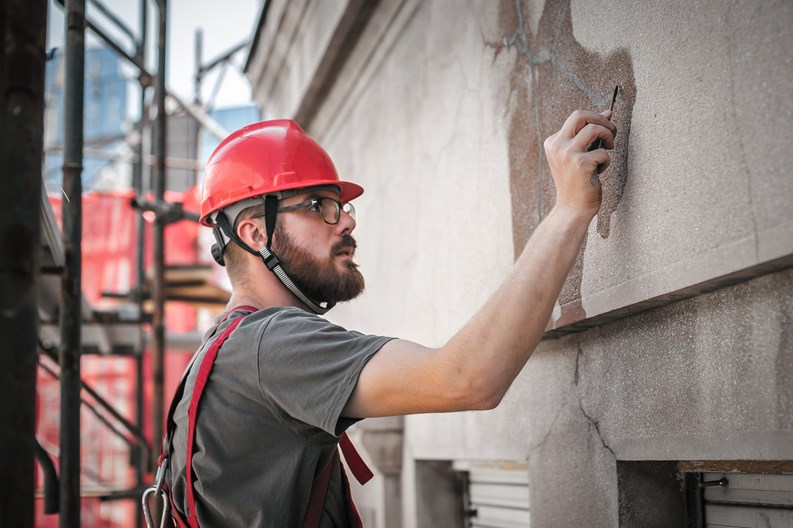In cities across the country where tall buildings are the norm, Departments of Buildings require façades to be inspected at regular intervals for structural and material soundness. But as with many such regulations, there can be significant costs and disruptions associated with compliance, especially in residential buildings—leading some to defer inspections and repairs until the last minute. Co-ops and condos have the additional hurdle of board governance, where important decisions go through a body of elected volunteers who may or may not have expertise in engineering or the like, and who generally have an interest in keeping their and their neighbors’ carrying charges low. This can lead to underfunded reserves, or other challenges in funding capital repairs.
When considering all these factors together, it’s no wonder that co-op and condo boards dread having to undertake major façade projects. The scope can be immense, the cost into the millions of dollars, and the challenges and headaches seemingly endless. But with prudent planning and a realistic outlook, it’s possible to get through one of these high-ticket projects in one piece.
So it Begins
Chicago’s Façade Ordinance, enacted in 1996, requires all high-rises over 80 feet tall to file reports under its Exterior Wall Program, with varying levels and frequencies of inspection depending on building type. Boston’s 1995 Façade Ordinance, amended in 2022, requires that buildings taller than 70 feet in height undergo a façade inspection at least once every 5 years, and buildings taller than 125 feet be inspected at close range with the same frequency. Jersey City, New Jersey, recently enacted a law that requires buildings taller than six stories and masonry façade buildings four stories or taller to be professionally inspected every five years.
A Job for the Pros
While routine check-ups by in-house staff or management personnel are part and parcel of the maintenance of a building, a spontaneous issue may suddenly arise, giving a board occasion to call in specialists to look at or work on the property. As architects, engineers, contractors and the like can prove costly, it’s important to know when to get in touch, and what to expect.
Peter Power, R.A.; and Todd Gorrell, R.A. are the chairman/CEO, vice president, and associate principal, respectively, of Chicago-based restoration architectural and engineering firm Klein and Hoffman. According to them, the frequency of exterior inspection depends on the nature of a building’s construction. “If we’re talking about an older masonry structure—especially what we call ‘transition buildings’ that have steel structure in and among the masonry—they can require very frequent close-up inspection,” they say. “An older building that’s pure masonry and doesn’t have a steel structure may require less. By the same token, if it’s a glass and steel high-rise, there may be little to do from a safety perspective, but they can have as many or more problems as older buildings. So it’s all quite dependent on the building type.”
As a general rule, you’ll want to do a visual inspection on a low- or mid-rise building every few years, with some level close-up inspection maybe once every four.”
Chicago’s Façade Ordinance
In 1974, a Chicago woman was tragically killed when she was hit by loose bricks that fell from a 16-story building in the city. Two years later, Chicago issue d the country’s first façade ordinance … but it was repealed. The city went 20 years before its periodic inspection ordinance was enacted in 1996 under its Exterior Wall Program, requiring all high-rises over 80 feet tall to file reports, with varying levels and frequencies of inspection depending on building type.
Rachel Michelin, AIA, LEED AP BD+C, principal and co-office director in architecture and engineering firm Thornton Tomasetti’s Chicago office, takes us through the typical process: “When our team conducts exterior wall inspections,” she says, “we look for visible issues such as cracking, spalling, bulging, or displaced areas. The presence of cracking can result in potential larger problems down the road. Small cracks allow water to enter the exterior wall system, which can cause issues due to Chicago freeze-thaw cycles (i.e., accumulated water freezes within the system and causes damage to the materials), or the corrosion of embedded, unprotected steel elements, such as shelf angles, ties, or rebar. As steel corrodes, it expands in volume. This puts more pressure on the surrounding system and creates spalling. This is especially important for Type III buildings, where embedded steel is not protected by coatings or a flashing system.”
The inspection process is multi-sensory, Michelin says, using sight, touch, and even hearing. “Sometimes spalling or delamination can occur, even if not readily apparent,” she explains. “For this reason, during our hands-on observations, we also use sounding mallets or hammers to acoustically assess the existing conditions. Delaminated materials will sound ‘hollow’ compared to materials in good condition. This comprehensive ‘check-up’ allows us to thoroughly assess the building’s condition and determine the needs for further maintenance or repairs.”
Kelli Rick, a Chicago property manager with FirstService Residential Illinois, says that the path from a required inspection to a major façade project depends on many factors, including but not limited to the building’s materials, its age, and what conditions were uncovered during inspection. “[Inspectors] look for cracks, concrete spalls, metal flashing deterioration, failing window seals, interior leaks... it all depends on the type of façade,” she says. “When individual, piecemeal repairs are no longer feasible or cost effective, it may be time to consider a major repair. The important thing to remember is that small problems become big ones when not addressed. And hopefully it doesn’t come to this, but chunks falling off the building is definitely a red flag.”
Even in states and localities where the law doesn’t require such inspections, professionals in the field recommend they be performed as if they were mandated. “I would advise associations to have an engineer inspect their façade at least once every five years,” says Glen A. Masullo, president of Preferred Community Management Services, which has locations in New Jersey and Pennsylvania. Eric Janczyk, principal of Nova Restoration, a façade maintenance and restoration company located in Brooklyn, New York suggests that side and rear elevations be inspected every three to five years in addition to façades, whether they fall under required local inspection guidelines or not. And architecture and structural engineering firm Klein & Hoffman, with offices in Chicago, Milwaukee, and Philadelphia, contends that newer buildings should be inspected with greater frequency than older buildings, which were simply built better. (Of course, older buildings might also have a Landmarks designation or be located in a historic district, opening a whole other can of worms.)
A Bridge to Nowhere
The pros all say that the first step for a building assessed as anything other than “Safe” is to install protective measures around it to keep residents and passers-by safe until the necessary repair work can be done. Technically called bridging, but also known as a building canopy, sidewalk shed, girdle, or scaffolding, the structures are ubiquitous in cities with façade inspection requirements like those mentioned above, mostly because they are a mandated part of the safety plan and must remain in place until required repairs are complete, inspected, and signed off—which can take years and sometimes decades. “Despite complaints,” says Janczyk, “we are not overdoing it with canopies.”
Since the rental and installation of the bridging can be among the most significant line items of a façade project, it makes sense to complete as much work as possible while it’s in place. “Once you’ve done the mobilization for the project, it’s best to finish it at one time,” Janczyk advises, “because if you don’t, each time you do some portion of the work, you will have to put up and take down the canopy, which is a very expensive proposition.”
Robert McBride, consultant for the Bedford, Massachusetts, community association management company The Dartmouth Group, AAMC, AMO, an Associa Company, adds, “A comprehensive investigation should be conducted in order to determine if a façade problem is isolated or systemic. It’s key to investigate intersections—i.e., roof-to-wall, wall-to-sidewall, or roof-to-chimney, and so on. During this process, an assessment of the underlying structure needs to be made. Is there extensive rot in the wall sheathing? Are window sills and frames rotted? Is there extensive deflection or sagging of roof sheathing? Depending on the nature of the construction—i.e., clapboard versus masonry—signs of deterioration may or may not be immediately evident. The most important next step is to not simply replace the rotted material or repaint. It’s critical to find the source of any damage.”
Power and Gorrell also urge boards to pay attention to sealants. “Sealants have a limited useful life and have quite often outlived their usefulness by the time we’re called out,” they explain. “That’s something easy for associations to keep tabs on. Because once the sealants go, water is coming into the building, and the damage may be done before we get there. It grows exponentially over time, especially in masonry or exposed concrete construction.”
Additionally, from a masonry standpoint, boards can look for efflorescence, which is the white staining that can accumulate on brick, and is a signal of water penetration into that wall, according to the pros. And on concrete buildings, or on any service where things can corrode, peel or rust, these indications of aging may warrant a look to see if there’s a larger underlying problem.
Another issue which boards and individual owners alike may be inclined to overlook is glass breakage. “Oftentimes unit owners don’t report cracked windows, but that’s a dangerous situation; that window has lost some level of structural capacity,” say Power and Gorrell. “It may be stable under normal conditions, but add wind, and it’s unpredictable.”
“We’ve had cases recently where there’s been spontaneous glass breakage,” they continue. “It happens from impact, or movement of window frames. In Chicago, the building department will cite a building due to broken glass. Many associations, unfortunately, relegate the responsibility for individual panes of glass to the owner, and many owners don’t want to pony up $300 or $400 or even $1,000. But, in my opinion, they have a fiduciary duty to themselves and to the association to identify a piece of broken glass as soon as they know about it.”
“There are a lot of things that need to be done—and done right,” say Power and Gorrell. “And you need to specifically seek out qualified professionals; many people who go about designing new buildings know virtually nothing about repairing them. The latter is a science and art unto itself - a specialized subset that needs to be correct, as it’s extremely expensive to fix building facades. A very high percentage of what an association spends on a repair goes to just getting the vendor access to the work that needs to be done, so we tell people to spend the money and get it done in one shot, rather than drag it out and have someone come out and install new scaffolding three or four times just to attain that access.”
Where vetting is concerned, the executives at Klein and Hoffman recommend reviewing potential vendors’ resumes and assessing the depth of their experience. “You want to see continually demonstrated success, not just stuff they did last year,” they say. “You’ll want references and examples of successful projects that compare to your property and the shape and scope of what you need. And we get recommendations from existing condo clients. Most associations are aware of other, similar associations. Call them up! Ask them how their projects went with their vendors. You’ll find them to be amazingly candid.”
As a last word of advice for boards of newer associations, the pros recommend that they immediately start saving for a rainy day. “It’s pretty common for a new association to have minimal money put away toward reserves, as it may assume that it won’t have any problems for many years,” says Powers. “But then they learn that there were flaws in the construction, such that they need to put out large special assessments. And we’re finding that these bigger flaws tend to show up right around the time that a developer’s two- or five-year warranty is gone. It’s at that point that stuff hits the fan.”










Leave a Comment